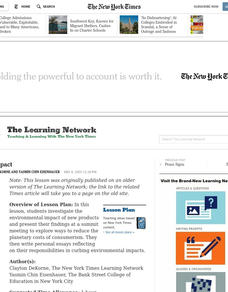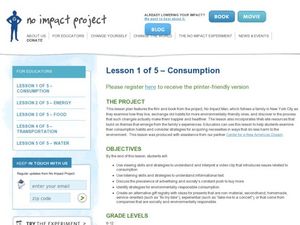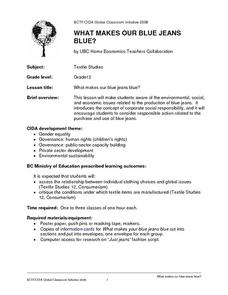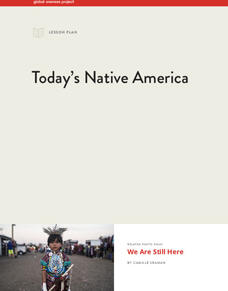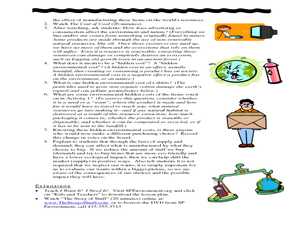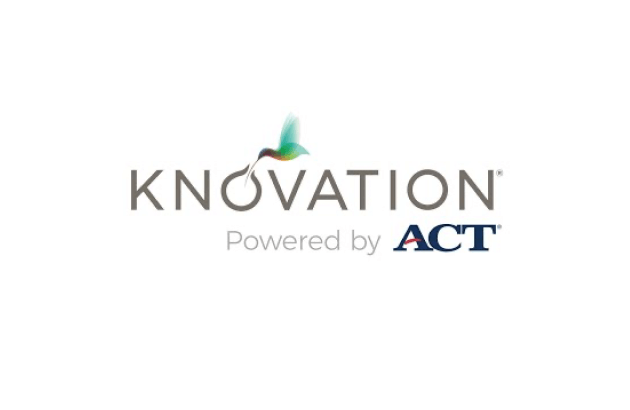Curated OER
Globalization and Consumerism
Is the expansion of American corporations abroad a good or bad thing? After examining the global operations of Ford Motor Company, McDonald's, and Walmart, class members are asked to evaluate the impact of globalization and consumerism.
Global Oneness Project
Deconstructing Consumerism
To increase awareness and launch a discussion of consumerism, class members view What Would It Look Like, a 25 minute film of images that capture the global effects of the consumption of goods. Viewers make a list of the images that they...
Advocates for Human Rights
The Right to a Clean Environment in the United States
Even if a school has gone digital, chances are there's still plenty of paper being used. The three activities help scholars learn about the environmental impact of paper and another consumer products of their choosing, the issue of...
Curated OER
Deep Impact
How can acknowledging opposing viewpoints reinforce one's argument? Use this New York Times lesson to study consumerism and the environmental impact of new products. After reading the article "Whether a Hummer or a Hybrid, the Big...
Global Oneness Project
Deconstructing Consumerism
A short, engaging video provides a critique of the hyper-consumerist mentality that many think have taken over the Western world. After watching the video, pupils reflect on their own habits and use evidence to respond to discussion and...
EduGAINs
Consumerism, Me and the Natural Environment— Canadian and World Studies
Just as no man is an island, no country is totally independent of other countries. To understand the impact of individual consumer decisions on the global natural environment, class groups consider how the stuff they purchase connects to...
WE Charity
Elementary–Module 2: Circular Economy and Nature
How can people do their part to help protect the environment? Learners participate in an engaging jigsaw activity to discuss the causes and effects of pollution. Next, pupils develop their own innovative ideas to address an environmental...
Curated OER
Images as Messages
Your class watches a video about Chris Jordan, a talented photographer and activist who tries to get an environmental message out by his work. As a cross-curricular project, have your class imitate his style of art with an object that...
Curated OER
Consumption
Students analyze the issue of consumption using the No Impact Project. In this consumption lesson, students watch a video about issues related to consumption. Students discuss the prevalence of advertising and society's need for...
Curated OER
WHAT MAKES OUR BLUE JEANS BLUE?
Twelfth graders become aware of the environmental, social and economic issues related to the production of blue jeans. They explore the relationship between individual clothing choices as well as global issues. In addition, they...
Curated OER
Packaging: What a Waste!
Young scholars examine the environmental and economic impacts of excess packaging. They investigate the price and relative amount of processing and packaging of different food products in a local grocery store, analyze graphs, and...
Dick Blick Art Materials
“Gawu” — African-influenced Tapestry
Here's a great way to combine environmental science with art. Kids use recycled materials to create their own Gawu, a tapestry made of discards. Although designed for special education classrooms, the activity is sure to engage all...
Global Oneness Project
Today’s Native America
The 2016-2017 protests over the Dakota Access Pipeline (DAPL) motivated Camille Seaman to create "We Are Still Here," a photo essay featuring portraits of contemporary Native Americans who protested the pipeline. This eight-page packet,...
Curated OER
Products of the Rain Forest
Seventh graders explore products of the rain forest. They consider items from their home that may have been products of the rain forest by checking ingredients on product labels. They share their discoveries in class and create a...
Curated OER
Consumerism and the Consumer Society
High schoolers read an article titled "How Much Is Enough?" by Alan Durning. They work in small groups to summarize the author's main point for each paragraph and then identify and discuss further questions they may have in response to...
Curated OER
The True "Cost of Cool!"
Eighth graders study hidden environmental costs in things we buy. In this consumerism lesson students watch a video about consumerism and analyze advertisements in teen magazines.
Curated OER
Food Systems Feed the World
Sixth graders consider the source of their nutrition. In this food systems activity, 6th graders discuss how food gets to the table and the process it goes through. Students reflect on world hunger issues, farming, and consumerism...
Curated OER
Need vs. Wants in Creating Sustainable Communities
Ninth graders create a T chart of their needs and wants. In this environmental science lesson, 9th graders brainstorm ideas on how to create a sustainable community. They decide what they would give up and keep to make the community...
Curated OER
Environment or Economy?
Students develop counterarguments to John Mizzoni's article on business sustainability. In this economics vs. environment lesson, students present examples of greenwashing and support them with rationale. They also discuss whether carbon...
Curated OER
Community Evolution: Putting the Puzzle Together
Students, working in groups, to study on aspect of their community history. They put their research together in one story about their community.
Curated OER
Affluenza
Students are introduced to the "disease" of affluenza. After watching a documentary, they identify the forces that have changed the nation into a consumer society. As a class, they discuss ways to avoid catching on to this phenomenon.
Other
Story of Stuff Project: The Story of Stuff
Activist Annie Leonard narrates this anticonsumerism video that traces the links between what we consume as finished goods and what is consumed in the production of those goods. The hidden costs of consumption-costs attributable to...





